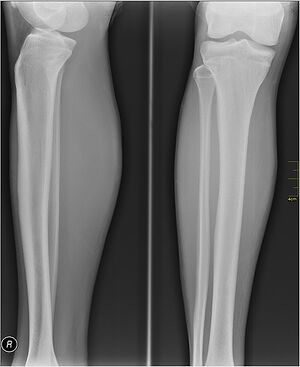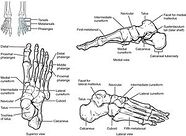Bones of the lower limb
Bones of the lower limb or ossa membri inferioris just like the upper limb, they are formed by a girdle (cingulum membri) and the skeleton of the free limb (skeleton membri liberi).
The girdle of the lower limb[edit | edit source]
The plexus of the lower limb is formed by a single bone - the pelvis ( os coxae , which is formed by the union of 3 components connected during development by synchondrosis ) . It is articularly connected to the sacrum, and in the pubic clasp it is connected to the ipsilateral pelvic bone. This creates a closed structure - the pelvis .
Os coxae is made up of 3 bones: hip bone ( os ilium ) , ischial bone ( os ischii ) , pubic bone ( os pubis ) . The cartilaginous boundaries of all 3 bones meet during development in the form of the letter Y in the fossa of the hip joint ( cartilago ypsinoformis ).
Skeleton membri inferioris liberi[edit | edit source]
Thigh bone ( femur )[edit | edit source]
The femur is the largest and strongest bone in the human body. It has 4 main parts:
- Caput femoris - head of the femur, fits into the socket of the acetabulum and is part of the hip joint;
- Collum femoris - the neck of the femur, connects the head to the body, forms a collodiaphyseal angle with the corpus with an average value of 125°, one of the most common fractures on the lower limb;
- Corpus femoris - the body of the femur, the longest part of the bone, on the upper side it extends into 2 tufts - trochanter major et minor ;
- Condyli femoris − on the distal side expands into 2 bumps − epicondylus lateralis et medialis , which are part of the knee joint..
Patella[edit | edit source]
The patella is considered the sesamoid bone in the insertion tendon of the quadriceps femoris muscle. It has facies articularis, facies anterior and basis and apex patellae . Apex is hidden in leagues. patellae . The patella is palpable along its front surface and along its circumference (through the tendon of the quadriceps femoris muscle ).
Ossa cruris (leg bones)[edit | edit source]
This includes the tibia − medially and the fibula − laterally.
Tibia[edit | edit source]
It is a strong bone, placed medially in front. It is divided into 3 parts:
- The proximal part - it consists of 2 wide articular bumps - condylus lateralis et medialis , both of which bear at their proximal end articular surfaces ( facies articularis superior ) for contact with the condyles of the femur
- The body of the tibia ( corpus tibiae ) − strong, triangular
- The distal part - extends into the inner ankle - malleolus medialis
On the front side, between the condyles, there is a massive roughness - tuberositas tibiae , where the tendon of the quadriceps femoris muscle - lig. patellae .
Calf bone ( fibula )[edit | edit source]
The fibula is a thin bone, located laterally and posteriorly. It cannot be said that it has a direct load-bearing function, it serves mainly as a place of muscle beginnings (e.g. mm. fibulares). It again has 3 parts:
- Caput fibullae − the head of the fibula bone, carries the articular surface for connection with the tibia, just below it is the collum fibullae , the biceps femoris muscle is attached to the head ;
- Corpus fibullae − has 4 edges − anterior, posterior, internal and ventromedial;
- Malleolus lateralis (outer ankle) − extends further distally than the inner ankle, it is connected to the tibia by a syndesmosis complete with an articular cleft.
Leg bones (ossa pedis)[edit | edit source]
Tarsal bones ( ossa tarsi ) [edit | edit source]
There are 7 metatarsal bones forming the tarsus pedis :
- Ankle bone (talus) - articulated with the bones of the lower leg, its parts are trochlea, collum, caput (articular surface for articulation with os naviculare), processus posterior - extends backwards, there is a groove called sulcus tendinis musculi flexoris hallucis longi;
- The heel bone (calcaneus) - the largest, anteroposteriorly elongated bone of the instep, has 3 articular surfaces on the dorsal side of the bone - facies articularis talaris anterior, media, posterior , sustentaculum tali - a protrusion of the heel bone supporting the talus, the other parts are the tuber calcanei (a conspicuous structure, clamps with the tendon of the triceps muscle − Achilles tendon ) and facies articularis cuboidea ;
- Navicular bone (os naviculare) - proximally the articular surface for the caput tali, distally 3 triangular surfaces for the ossa cuneiformia, there is a noticeable roughness - tuberositas navicularis, which is palpable in the living;
- Cuboid bone (os cuboideum) − irregular shape, proximally it has a wavy curved articular surface for connection with the calcaneus, distally articular surfaces for metatarsal axis IV and V and medially articular surface for connection with the external sphenoid bone;
- Cuneiform bones (ossa cuneiformia) - there are three: os cuneiforme mediale (the largest), intermedium and lateral.
In the assembly of the metatarsal bones, we find 2 proximodistal stripes :
- In the assembly of the bones of the metatarsals we find
- internal − talus − os naviculare − 3 ossa cuneiformia − 3 ossa metatarsalia
- outer − calcaneus − os cuboideum − 2 ossa metatarsalia
Metatarsal bones ( ossa metatarsi ) [edit | edit source]
These are 5 metatarsal bones ( os metatarsale ), designated by the Roman IV. Each has 3 parts − basis, corpus, caput . Together they form the metatarsus of the foot (instep). They are similar in structure, development and ossification to the metacarpus of the hand.
Bones of the toes ( ossa digitorum pedis ) [edit | edit source]
The skeleton of the fingers is formed by the phalanges digitorum pedis . Each finger has 3 joints − phalanx proximalis, media et distalis , the exception is the thumb, which has two joints (it does not have a phalanx media). Each article can again be divided into 3 parts - basis, corpus, caput .
Links[edit | edit source]
Related articles[edit | edit source]
References[edit | edit source]
- ČIHÁK, Radomír – GRIM, Miloš. Anatomie. 2., uprav. a dopl edition. Praha : Grada Publishing, 2002. 470 pp. vol. 1. pp. 253-272. ISBN 80-7169-970-5.




